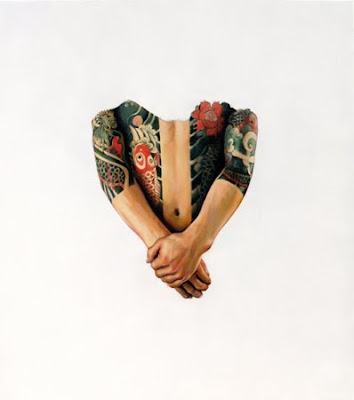Meagher’s portraits of tattooed body parts give voice to the permanence of the gesture of inking the skin and show the idealised indestructibility of our human shell.
 Meagher is but a mildly tattooed man, he has only one tattoo, he tells me, of a fighting cock. It holds no grand meaning whatsoever except to cover up a previously tattooed past tense girlfriend’s date of birth and came about in a session of perhaps a bit too much to drink with his prolific tattoo artist friend Yoshi.
Meagher is but a mildly tattooed man, he has only one tattoo, he tells me, of a fighting cock. It holds no grand meaning whatsoever except to cover up a previously tattooed past tense girlfriend’s date of birth and came about in a session of perhaps a bit too much to drink with his prolific tattoo artist friend Yoshi.
So his fascination with tattooing is a kind of a cross-cultural empathy with human ritualistic practices. I say ritualistic because of the deep seated history of tattooing throughout the history of mankind and its purpose often being to the end of spiritual annunciation, declarations of love, or simply the permanent appreciation of an image. All of this deep meaning comes about through the initial process of pain, scarring, blood and ink penetration of the surface. The tattooed man forever seeks his fellow men to read the semiotics of his skin in context with the image he has displayed upon it.

Meagher’s practice of painting his subjects often does this to me as I wonder what this stoic and softly spoken man with bonnie baby blue eyes and slightly pink flushed cheeks could want with the darkness of etched skulls and scarred skin; thus his fighting cock comes across tongue in cheek, perched upon his shoulder blade as a trophy of youthful decisions and revisions. In his work, he is more considered and more serious it seems when it comes to the message a tattoo begets; the fact that his subjects have no faces, or eyes to tell you their stories demands that the tattoo reveal all. Or at least Meagher requests that you imagine the man attached to the tattoo and kills off the stigma you can place upon the man in the context of brash body art. He reduces it to the purely symbolic, the simply aesthetic. There is no evidence of pain or social stigma here, just skin revealing symbols that have been recontextualised for the viewer to place new meaning upon for themselves.
 If you like a tattoo he has painted, you can own this body art in all its permanence without scars, the smell of scorched flesh or blood. Body art becomes beautiful as ever, just as Harley Davidsons can never be more spiritual or romantic as they are according to Hunter S. Thompson’s Hell’s Angels.
If you like a tattoo he has painted, you can own this body art in all its permanence without scars, the smell of scorched flesh or blood. Body art becomes beautiful as ever, just as Harley Davidsons can never be more spiritual or romantic as they are according to Hunter S. Thompson’s Hell’s Angels.
Meagher is also very talented at going beyond the surface of skin to capture a man inside his own. His recent portrait of James Powditch began its life with the haze of beauty cast over it bleeding the same arm’s length mirage of nostalgia as his tattooed series. But soon developed the surface details that betray the man beneath with 7 O’clock shadow, a roughness to the hands and worn out denim. Powditch is a man who has shown with great success at Ray Hughes Gallery, Australian Galleries and has painted, carved and sawn his way multiple times into the Wynne and Sulman Prizes including this year in 2010. Meagher’s 2010 portrait of Powditch has been selected for the Salon des Refusès at S. H. Ervin National Trust Gallery and will be on display from March 27th through until May 23rd.
 Work in Progress, James Powditch by Julian Meagher 2010, courtesy of the artist
Work in Progress, James Powditch by Julian Meagher 2010, courtesy of the artistis upcoming body of work to be shown in a group hang at Chalk Horse as of Thursday March 18th is an ode to Japanese Mikoshi festivals and an Australiana articulation of the equivalent practice: the heralding of the slab. This exhibition will be on display from March 18th to March 20th before Meagher’s work is shown at Edwina Corlett Gallery in Brisbane from April 15th.
 Images courtesy the artist and Chalk Horse
Images courtesy the artist and Chalk Horse


No comments:
Post a Comment